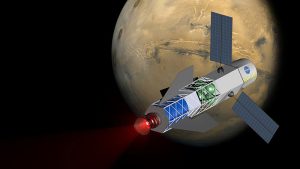
A UK-based rocket propulsion company has announced that it has started construction on a large nuclear fusion-propelled rocket that is intended to substantially shorten the travel time for a manned mission to our planetary neighbors. The construction of this type of engine is a risky gamble, as it relies on the parallel development of the nuclear fusion technologies that will be required to power the futuristic engine, a long-sought after development that has yet to be fully realized.
Pulsar Fusion is a UK-based company founded in 2011 that has developed two types of ion-engines for use as maneuvering thrusters for satellites; in July 2023 they announced that they have started construction on a Direct Fusion Drive (DFD) that is intended to produce thrust directly from the energy produced from nuclear fusion reactions. The reaction will be generated inside a stream of ultra-hot plasma contained by powerful magnetic fields within the drive itself, generating both electricity for the craft’s electrical systems and providing propulsive thrust by venting a portion of the plasma, combined with additional mass as propellant, through a magnetic nozzle aimed out the rear of the craft.
Such a propulsion method would allow a spacecraft equipped with a DFD to accelerate for a prolonged period of time at a rate higher than what current ion engines are capable of; conversely, chemical-based rocket engines can provide a great deal of acceleration, but tear through their fuel in a matter of minutes, limiting the top speed that they can reach. However, a craft capable of a prolonged period of acceleration, even if the rate of acceleration is lower, can reach a greater velocity than its brighter-burning chemical counterpart, allowing for an overall faster travel time over interplanetary distances.
Pulsar Fusion expects their 8-meter (26-foot) device to start testing sometime in 2027; however, this expectation is dependent on the successful development of the fusion technology that will power the engine, one of the holy grails of technological development that has proven to be frustratingly elusive. The fastest spacecraft built by our civilization so far is the Parker Solar Probe, of which reached 586,863 km/h (364,660) mph) on Nov. 21, 2021; however, it is important to bear in mind that this spacecraft achieved that speed by repeatedly using the gravity of Venus in a series of slingshot maneuvers.
“The difficulty is learning how to hold and confine the super-hot plasma within an electromagnetic field,” explains James Lambert, Chief Technology Officer of Pulsar Fusion. “The plasma behaves like a weather system in terms of being incredibly hard to predict using conventional techniques.”
To that end, Pulsar Fusion has partnered with Princeton Satellite Systems to develop machine learning algorithms to better predict the seeming chaos of these high-temperature tempests, in order to control the hydrogen plasma at the heart of the machine.
If they are successful, the company estimates that their DFD could propel an interplanetary craft to over 800,000 kilometers per hour (half a million mph), fast enough to cut the travel time for a manned trip to Mars in half, or quarter the time for an expedition as far out as Saturn from eight years to two.
Once again, this is all dependent on whether or not the hundreds of millions of degrees required to fuse the atoms in hydrogen plasma can be successfully controlled. “You’ve got to ask yourself, can humanity do fusion?” CEO Richard Dinan cautions. “If we can’t, then all of this is irrelevant.”
“If we can – and we can – then fusion propulsion is totally inevitable. It’s irresistible to the human evolution of space.”
Subscribers, to watch the subscriber version of the video, first log in then click on Dreamland Subscriber-Only Video Podcast link.
This would be an early version of the Epstein Drive from The Expanse novels/TV series if it ever functions. Still a rocket, but one that can burn 24/7, giving constant linear acceleration so you have artificial gravity the entire trip except for the midpoint flip and burn. Sounds like the thrust produced will be small, but constant small thrust still shortens trips drastically. If the efficiency is ever improved like the Epstein Drive to produce at least 1/3 G acceleration, it would “change everything”, you could get to the moon in hours, Mars in a few days, the gas giants in a week.
My prediction… 30 years 😉